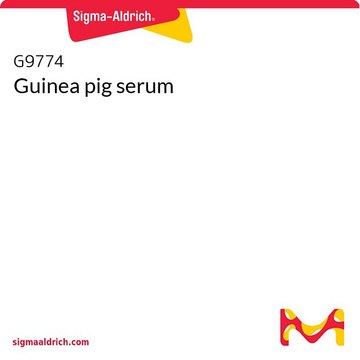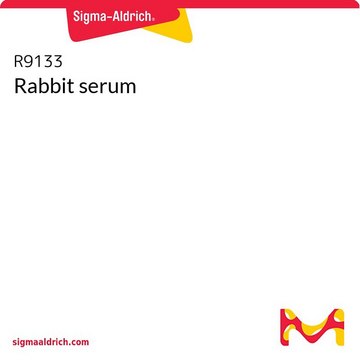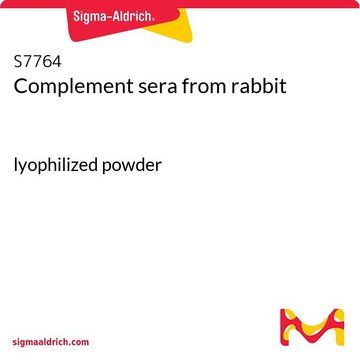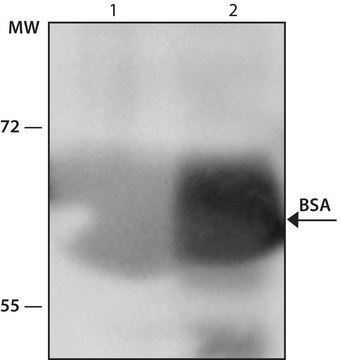추천 제품
생물학적 소스
rabbit
Quality Level
결합
unconjugated
항체 형태
whole antiserum
항체 생산 유형
primary antibodies
클론
polyclonal
포함
15 mM sodium azide
종 반응성
mouse
기술
immunoelectrophoresis: suitable
배송 상태
dry ice
저장 온도
−20°C
타겟 번역 후 변형
unmodified
일반 설명
Mouse serum comprises hormones, antigens, electrolytes and antibodies. It serves blocking agent in immunoassays.
특이성
Strong reactivity with normal mouse serum has been determined by immunoelectrophoresis (IEP). This antiserum has not been assayed for interspecies crossreactivity.
애플리케이션
Anti-Mouse Serum antibody produced in rabbit has been used in differential fluorescent labelling. It has also been used in differential staining of inner cell mass (ICM) and and trophectoderm (TE) cells. It has been also been used in the removal of zona pellucidae for the isolation of inner cell mass (ICM) from mouse blastocysts.
Anti-Mouse Serum antibody produced in rabbit was used as blocking agent in differential cell count of trophectoderm and inner cell mass cells of mouse embryos.
물리적 형태
Rabbit Anti-Mouse Serum is provided as a liquid containing 15 mM sodium azide as preservative.
저장 및 안정성
For continuous use, store at 2-8 °C for up to one month. For extended storage, the solution may be frozen in working aliquots. Repeated freezing and thawing is not recommended. Storage in "frost-free" freezers not recommended. If slight turbidity occurs upon prolonged storage, clarify the solution by centrifugation before use.
면책조항
Unless otherwise stated in our catalog or other company documentation accompanying the product(s), our products are intended for research use only and are not to be used for any other purpose, which includes but is not limited to, unauthorized commercial uses, in vitro diagnostic uses, ex vivo or in vivo therapeutic uses or any type of consumption or application to humans or animals.
적합한 제품을 찾을 수 없으신가요?
당사의 제품 선택기 도구.을(를) 시도해 보세요.
Storage Class Code
10 - Combustible liquids
WGK
WGK 3
Flash Point (°F)
Not applicable
Flash Point (°C)
Not applicable
Effects of paternal heat stress on the in vivo development of preimplantation embryos in the mouse
Zhu BK and Setchell BP
Reproduction, Nutrition, Development, 44(6), 617-629 (2004)
U Sanmee et al.
Theriogenology, 75(9), 1682-1687 (2011-03-02)
We studied the co-culturing effect of intact and half-destroyed 4-cell mouse embryos on blastocyst formation rate and cell counts. A laser beam was used to produce a hole and destroy an adjacent blastomere in two opposite areas of the zona
Namfon Inna et al.
Clinical and experimental reproductive medicine, 45(3), 110-115 (2018-09-12)
To compare our in-house method of embryo freezing with Cryotop vitrification in terms of immediate survival, subsequent cleavage and blastocyst formation, and cell numbers in blastocysts. Two-cell mouse embryos were randomly allocated into three groups: a non-frozen control group (group
Both the folate cycle and betaine-homocysteine methyltransferase contribute methyl groups for DNA methylation in mouse blastocysts
Zhang B, et al.
Faseb Journal, 29(3), 1069-1079 (2015)
Bi-ke Zhu et al.
Reproduction, nutrition, development, 44(3), 219-231 (2004-10-06)
This study was undertaken to investigate the effects of three media, volume and type of oil and frequency of observation on the in vitro development of mouse zygotes. B6CBF1 female mice (4 to 6 wk old) were superovulated using PMSG/hCG
자사의 과학자팀은 생명 과학, 재료 과학, 화학 합성, 크로마토그래피, 분석 및 기타 많은 영역을 포함한 모든 과학 분야에 경험이 있습니다..
고객지원팀으로 연락바랍니다.








